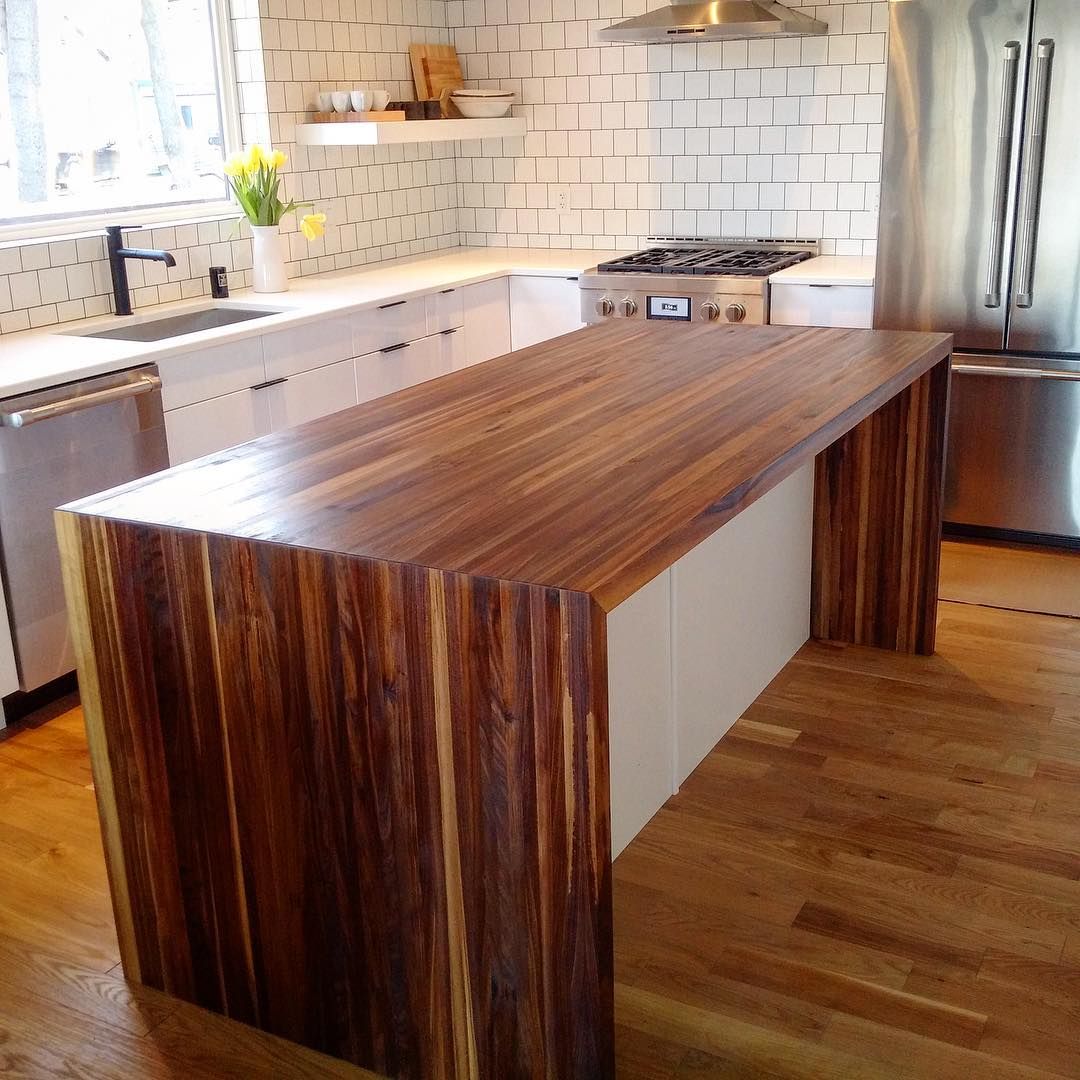Waterfall countertops: Where luxury meets functionality, creating a seamless and dramatic statement in any space. From kitchen islands to bathroom vanities, waterfall edges elevate design with their continuous flow and captivating presence. Explore the diverse world of waterfall countertops: Discover materials, costs, and expert installation tips to achieve a modern, sophisticated look that redefines your kitchen or bathroom.
Understanding Waterfall Countertops
So, what exactly is a waterfall countertop? It’s a design feature where the countertop material extends vertically down the sides of an island, cabinet, or vanity—creating a continuous flow from the horizontal surface to the floor, reminiscent of a waterfall. Unlike traditional countertops that stop at the cabinet’s edge, waterfall edges create a seamless, uninterrupted look. This striking design element instantly adds a touch of luxury and modern sophistication to any space.
Material Selection: A World of Options
One of the exciting aspects of waterfall countertops is the wide variety of materials available. Each material brings its unique character, durability, and maintenance considerations.
-
Quartz: Renowned for its durability, low maintenance, and vast color palette, quartz is an engineered stone and a favorite for busy kitchens. It resists scratches, stains, and heat, offering both practicality and style. Popular brands like Caesarstone offer an extensive selection of quartz options.
-
Granite: A classic choice, granite boasts natural beauty and unique veining patterns. Each slab is one-of-a-kind, adding character and a touch of timeless elegance. While durable, granite does require periodic sealing to prevent staining.
-
Marble: For unparalleled luxury and elegance, marble is the ultimate choice. Its smooth surface and distinctive veining exude sophistication. However, marble is more porous and susceptible to etching and staining. It’s probably better suited for bathrooms or less heavily used kitchen areas.
-
Laminate: A budget-conscious choice, laminate can impressively mimic the look of more expensive materials like granite or marble. Brands like Hampton Bay offer laminate waterfall countertops. While not as durable as stone, laminate offers a good balance of affordability and style.
-
Wood: Adding warmth and a natural touch, wood, especially walnut, creates a stunning waterfall edge. Live edge slabs with their natural, irregular shapes can be particularly striking. Butcher block is another wood option, offering a more rustic charm. However, wood requires regular maintenance to preserve its beauty.
Would you like to bathe in the luxury of a gorgeous kitchen? If so, Wayne’s Coating is the innovative solution that can make it happen for you.
Cost Considerations: Budgeting for Your Waterfall Edge
The cost of a waterfall countertop depends on several factors, including the material chosen, size, and design complexity. Laminate options can start as low as $80-$150, while high-end materials like marble and large custom pieces can reach upwards of $15,000. Here are some examples based on recent research:
- Laminate: $80-$152 per square foot
- Walnut: $1,318-$15,000 (depending on size and type)
It’s crucial to obtain multiple quotes from reputable installers to ensure you’re getting a fair price.
Design and Style: Creating Your Vision
Waterfall countertops effortlessly integrate into various design styles, from ultra-modern to traditional. Here are some popular applications:
-
Kitchen Islands: A waterfall edge transforms a kitchen island into a captivating centerpiece.
-
Bathroom Vanities: Elevate your bathroom with a spa-like ambiance using a waterfall edge on your vanity.
-
Other Applications: Waterfall edges can also enhance bars, reception desks, and other surfaces where a design statement is desired.
Consider the overall aesthetic of your space and choose a material and edge profile (e.g., mitered, eased, beveled) that complements it best.
Installation: The Importance of Expertise
Installing a waterfall countertop is a complex process best left to experienced professionals. Precise measurements and meticulous fabrication are essential for a seamless fit and flawless finish. A professional installer possesses the expertise to handle the weight and fragility of certain materials, ensuring a safe and successful installation.
Weighing the Pros and Cons
Pros:
- Dramatic Visual Impact: Creates a luxurious and modern focal point.
- Enhanced Durability: Protects cabinet sides from wear and tear, especially in high-traffic areas.
- Concealed Storage: Can cleverly hide storage underneath.
- Modern Aesthetic: Adds a contemporary touch to any space.
Cons:
- Higher Cost: Requires more material and specialized fabrication.
- Professional Installation: Essential for optimal results.
- Maintenance: Varies depending on the material; some require more care than others.
Are Waterfall Countertops Still in Style?
Absolutely! Waterfall countertops continue to be a sought-after design element. Their timeless appeal, seamless design, and ability to blend functionality with visual impact suggest their popularity will endure. However, it’s important to weigh the pros, cons, and your budget before making a decision.
Disadvantages to Consider
While visually stunning, waterfall countertops have potential drawbacks:
-
Cost: The increased material and complex fabrication contribute to a higher price tag.
-
Maintenance: The seamless surface can show fingerprints, smudges, and water spots, requiring frequent cleaning.
-
Durability: Exposed edges are more susceptible to chipping or cracking from impacts.
-
Trend Dependency: While currently popular, design trends evolve. Consider the long-term aesthetic and potential impact on resale value.
-
Practicality: The higher maintenance and potential for damage may not suit all lifestyles, especially busy households with children.
The Verdict: A Statement of Style and Functionality
Waterfall countertops offer a unique blend of beauty and practicality. While the cost and installation complexity may be higher than traditional options, the visual impact and enhanced durability can make them a worthwhile investment. Carefully consider your budget, lifestyle, and aesthetic preferences to determine if a waterfall countertop is the right choice for you. Consulting with a kitchen designer or contractor can provide valuable insights based on your specific needs. By incorporating sustainable materials and exploring DIY alternatives, you can further personalize and enhance the appeal of your waterfall countertop.
- The Best Battery Picture Lamps for Effortless Artwork Illumination - April 1, 2025
- Double Sink Bath Vanity Tops: A Buyer’s Guide - April 1, 2025
- Bath Towel Measurements: A Complete Guide to Choosing the Right Size - April 1, 2025










